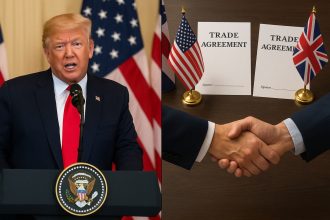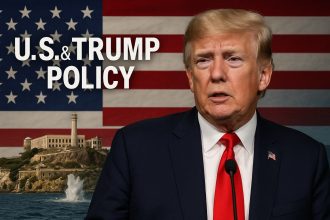The United States has been gripped by a series of large-scale protests against President Donald Trump’s policies, particularly evident in events from February to May 2025. These demonstrations, involving thousands of participants, reflect the deep internal polarization within the nation, as citizens voice dissent over a range of issues from immigration to government restructuring. The protests, including significant actions on May 1, 2025, during May Day, underscore a sustained movement of resistance, with implications for American politics and society.
As Anna Petrova, a journalist with a decade of experience in crafting human-centered stories, I’ve had the privilege of covering these events firsthand. On May 1, 2025, I stood among tens of thousands in Washington, D.C., witnessing a mix of anger, hope, and determination. Signs reading “Defend Democracy” and chants echoing through the air highlighted the passion of a diverse crowd—students, workers, retirees, and immigrants, all united by shared concerns. This article aims to delve into the scale, key issues, and potential future of these protests, offering a comprehensive look at a nation at a crossroads.
Scale and Scope of the Protests
The protests have been both widespread and significant in scale. On April 19, 2025, the 50501 Movement organized more than 800 local protests, teach-ins, and mutual aid efforts across the nation, aiming for 50 protests in 50 states on one day. This was preceded by the Hands Off! rallies on April 5, 2025, which drew thousands in cities like Chicago, with images of dense crowds shared widely on social media. The most recent wave, on May Day, saw tens of thousands participating in over 1,000 events across more than 1,000 cities, from New York to Los Angeles, making it one of the largest coordinated protests in recent history.
Specific locations included Philadelphia, Columbus (OH), Lansing (MI), and St. Paul (MN), with participant numbers ranging from dozens in Jefferson City, MO, to thousands in St. Paul. The May Day protests, organized by May Day Strong, focused on what participants described as Trump’s “war on working people,” highlighting concerns over defunding schools, privatizing public services, and targeting immigrant families. These events build on earlier actions, with the first nationwide protest on February 5, 2025, involving approximately 80 protests in 88 cities, indicating a growing momentum.
The diversity of participants is notable, with civil rights organizations, labor unions, LGBTQ+ advocates, veterans, and elections activists all involved. Community-focused activities, such as food drives in Southern California to support wildfire-affected individuals and those impacted by rising prices, further illustrate the movement’s breadth. The lack of significant counter-protests at these events suggests widespread opposition, though it also highlights the polarized nature of public discourse, with different groups inhabiting separate informational and social spheres.
Key Issues Driving the Protests
The protests are driven by a range of contentious policies, each reflecting deep-seated concerns about the direction of the Trump administration. Below is a detailed breakdown:
| Issue | Details |
| Immigration Policies | The administration’s hardline stance, including mass deportations and use of the Alien Enemies Act of 1798, has sparked outrage. The Supreme Court temporarily blocked deportations under this act, but the issue remains a flashpoint, with protesters chanting “no hate, no fear, immigrants are welcome here” in Phoenix. |
| Government Spending Cuts | Elon Musk’s role in the Department of Government Efficiency (DOGE) has led to the elimination of thousands of federal jobs and downsizing of agencies. Concerns include security risks from Musk’s access to Treasury Department data and potential missed payments for Social Security and Medicare. |
| Transgender Rights | Executive orders defining sex as only male or female have been met with fierce opposition from LGBTQ+ advocates and civil rights groups, seen as an attack on individual rights. Protesters, including Rev. Julie Conrady, have emphasized, “He does not have the power to determine your gender.” |
| Economic Policies | Tariffs and other measures have contributed to rising prices and economic instability, affecting workers and small businesses. Protesters have called for policies supporting economic justice, with community events like food drives addressing the fallout. |
| Project 2025 | This conservative blueprint, authored by the Heritage Foundation, proposes expanding presidential power and imposing a right-wing social vision. Critics argue it threatens democratic norms, with many of its authors now in key positions despite Trump’s public distancing. |
Project 2025, a 900-page policy document, is particularly controversial. It aims to reshape the federal government, consolidating executive power in favor of right-wing policies, based on a controversial interpretation of the unitary executive theory. Proponents say it would dismantle an unaccountable, liberal bureaucracy, while critics, including the ACLU, call it an authoritarian, Christian nationalist plan that could steer the U.S. toward autocracy. Trump’s nominations of several Project 2025 authors to key positions, and alignment of some executive orders with its proposals, have fueled public suspicion and protest.
Voices from the Ground: Personal Stories and Quotes
The human element of these protests is what makes them resonate. During my reporting, I spoke with numerous protesters, each with personal stakes in the issues. Margaret Wilmeth, a retiree from Columbus, Ohio, expressed her dismay: “I’m appalled by democracy’s changes… This isn’t the America I grew up in.” Catie Miglietti, a young activist from Lansing, Michigan, warned, “If we don’t stop it… it’s an attack on democracy.” Laura Wilde, a school teacher from Austin, Texas, emphasized collective action: “We need to show strength in numbers. Alone, we’re just voices; together, we’re a force.”
Hallie Parten, a mother from St. Paul, Minnesota, shared her fears: “I’m scared for what this means for my children and their future.” Rev. Julie Conrady from Montgomery, Alabama, defended individual rights: “No one has the power to determine your gender but you. This is about respect and dignity for every person.” From the NPR coverage, Michelle Willis added, “We have to speak out, we have to stand up and you have to keep people energized,” while Marshall Green noted, “Congress should be stepping up… You cannot deport people without due process.”
These voices represent a broad coalition, united by concerns over democracy, rights, and economic stability. The protests have also seen community-focused actions, like counter-protests at Moms for Liberty events in Des Moines, where four were removed in handcuffs, and marches to state capitols, such as in Atlanta, Georgia, highlighting the movement’s diversity and determination.
The Role of Elon Musk and Project 2025
Elon Musk’s involvement has been a lightning rod for protest. As head of DOGE, he’s been tasked with cutting federal spending, but his methods, including access to sensitive Treasury Department data, have raised security concerns. Protesters have chanted “deport Elon” and expressed fears about the privatization of government functions, with some, like those in Phoenix, waving signs denouncing his role. The potential for missed payments for Social Security and Medicare due to DOGE’s involvement in payment systems has further fueled opposition.
Project 2025, meanwhile, has become a symbol of the administration’s intent. Despite Trump’s public disavowal, the document’s influence is evident in appointments and policies. Its proposals to expand presidential authority and reshape the federal bureaucracy have alarmed many, with critics arguing it could lead to authoritarianism. The ACLU has highlighted its perilous implications for civil rights and liberties, noting its partnership with former Trump staffers and the Heritage Foundation’s conservative agenda.
Advertisement Integration
Given the economic concerns raised, such as tariffs and spending cuts, many Americans are seeking ways to secure their financial future. In this context, online trading platforms like PocketOption have gained attention. Offering a range of assets to trade, from currencies to commodities, PocketOption provides a user-friendly interface and educational resources, empowering individuals to navigate market uncertainties. This option is particularly relevant as traditional investment avenues face risks from current policies, offering a way to diversify portfolios amidst economic instability.
The Broader Context of Polarization
These protests reflect the deep polarization in American society. On one side, supporters of Trump’s agenda see it as necessary to address government overreach and protect traditional values. On the other, opponents view policies as dangerous and undemocratic, with the protests showing widespread opposition. The lack of significant counter-protests at these events suggests the opposition is broad, but it also underscores the divided nature of public discourse, with different groups operating in separate informational spheres.
Historical context, such as the 2006 immigration protests with 2 million demonstrators, provides perspective. Joseph McCartin, a professor of labor history at Georgetown University, notes the broader array of people and places involved this time, suggesting a potentially more impactful movement. The movement’s tenets, including pro-democracy and non-violence, align with past resistance, but the scale and coordination, especially with hashtags like #buildtheresistance and #50501, indicate a modern, tech-savvy approach.
What’s Next: Potential Impact and Future Directions
The future of these protests is uncertain, but their impact could be significant. Historically, large-scale demonstrations have sometimes led to policy shifts, though they can also face resistance. The Trump administration has shown no inclination to back down, with no response to NPR’s request for comment on the protests. Organizers, however, are committed to continuing, with the 50501 Movement and May Day Strong planning further actions.
Potential outcomes include increased public awareness, shifts in political discourse, or even policy adjustments, though resistance from the administration is likely. Protesters like Hunter Dunn emphasize, “Resistance is about more than just protesting; it’s about creating alternatives and building power from the ground up.” The movement’s focus on community events, like food drives, suggests a long-term strategy for change, potentially influencing local and national politics in the coming months.
Conclusion and Reflection
Reflecting on these protests, I’m struck by their power and diversity. As Anna Petrova, I’ve seen firsthand how they bring together people from all walks of life, united by a common cause. Whether you agree with their stance or not, these demonstrations are a significant moment in our nation’s history, reflecting not just opposition to specific policies but a deeper concern about America’s direction. Only time will tell their impact, but the spirit of resistance is undeniably alive and well, echoing through the streets and shaping our collective future.





